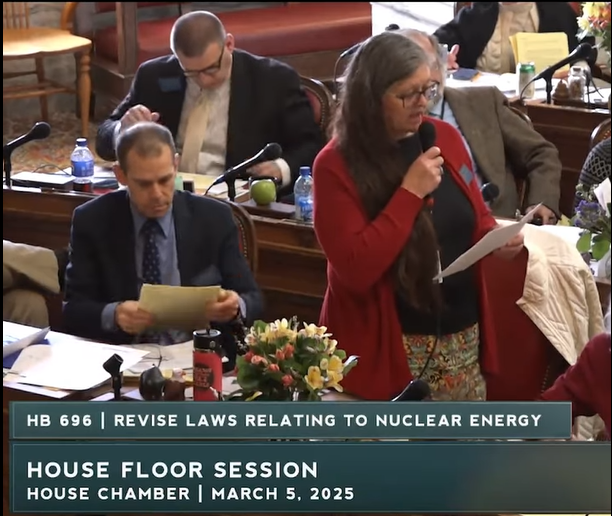by Nick Fitzmaurice
In 1978, Montana voters passed an initiative to require a citizen referendum to approve any nuclear power generating facility in the state. Disappointingly, the Legislature overturned this protection in 2021. This session, the Legislature paved the way for the nuclear industry to set up shop in Montana — all without local approval.
Rep. Gary Parry (R-Colstrip) sponsored two bills to bring nuclear energy to Montana, giving legislative authorization for siting nuclear waste storage facilities (HB 623) and uranium conversion and enrichment facilities (HB 696) in Montana.
Nuclear waste can remain hazardously radioactive for tens of thousands of years, yet the U.S. has no permanent repository for spent nuclear fuel. Therefore, the waste must be stored indefinitely on-site at nuclear power plants. Meanwhile, there are only two uranium enrichment facilities and one conversion facility in the nation. Siting these facilities in Montana would promote the development of a harmful uranium extraction industry in the state (Montana has extensive uranium deposits with hundreds of inactive mine sites, particularly in the southwestern part of the state). This would also position Montana as an international hub for hazardous uranium processing and associated waste streams for imported uranium fuel headed to final destinations outside of Montana.
The entire fuel cycle for nuclear energy is highly hazardous to public health and the environment, and is disproportionately harmful to Indigenous communities. Despite this, Rep. Parry and NorthWestern Energy are hoping that Colstrip will become a nuclear hub, though the new laws would allow for such development anywhere in the state.

Rep. Shelly Fyant (D-Arlee) speaks in favor of local approval on the House floor.
MEIC worked closely with members of the Montana American Indian Caucus to amend both bills to require votes of approval by people in the county where the facility would be located and by nearby Tribes. Unfortunately, after Reps. Shelly Fyant (D-Arlee) and Jade Sooktis (D-Lame Deer) successfully argued in favor of this amendment for HB 623 (which passed by a vote of 52-47 on the House floor), Rep. Parry urged the House to reject the same amendment on HB 696. That amendment failed 48-50. The Senate Energy and Natural Resources Committee stripped the amendment from HB 623 at Rep. Parry’s urging. Despite a valiant effort by Sens. Susan Webber (D-Browning), Shane Morigeau (D-Missoula), and Janet Ellis (D-Helena), the amendments were rejected on the Senate floor, and both bills were signed by the Governor.
Nuclear At Colstrip?
In early May, NorthWestern Energy, the U.S. Department of Energy, and the Southeastern Montana Development Corporation held two meetings in Colstrip, claiming to have completed a technical study on bringing nuclear development to town. They neglected to provide the attendees with that study, and as of this writing, the report is not publicly available. Members of the Northern Cheyenne peppered them with questions and concerns, which the presenters were unable to answer or evaded entirely.
MEIC contends that nuclear at Colstrip is simply not necessary. A recent study from RMI (formerly Rocky Mountain Institute) outlines how renewable energy could replace the Colstrip plant: 763 megawatts (MW) of solar, 918 MW of wind, and 364 MW of battery storage could reliably replace NorthWestern’s current and proposed shares of the coal plant and save ratepayers $529 million over the next few decades. While this isn’t trivial, 5.5 gigawatts (GW) of wind, 34 GW of solar, and 13 GW of batteries of utility-scale resources came online in the U.S. last year alone. That’s orders of magnitude higher than is needed to replace the Colstrip plant, and considering Montana has the second-highest wind generation potential and fourth-highest solar generation potential in the nation, this replacement power is well-within reach.
The renewed fervor surrounding nuclear energy is bolstered by big promises from industry and billions of dollars in subsidies and marketing support from the federal government. However, the technology has yet to live up to the hype. Vogtle (the only nuclear plant built in the United States in over three decades) took 15 years to build — almost twice as long as scheduled — with a final price tag of $36.8 billion, 163% over the original projection of $14 billion. Small Modular Reactors (SMRs) are no exception. NuScale’s flagship project for the only SMR design licensed for commercial operation by the U.S. Nuclear Regulatory Commission was cancelled in 2023 after cost projections more than tripled from $3 billion to $9.3 billion.
We need to bring carbon-free power online today, not 10 to 15 years down the road. We also need to listen to Indigenous communities that would be impacted by any proposed facility, and we certainly don’t need to saddle Montanans with billions of dollars in unnecessary costs and highly radioactive waste streams to manage in perpetuity. These bills are bad for Montana, but MEIC will continue fighting for a clean, just, and affordable energy future.
This article was published in the June 2025 issue of Down To Earth.

